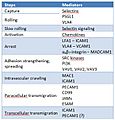Biochemical cascade facts for kids
A biochemical cascade, also known as a signalling pathway, is like a chain reaction inside your body's cells. Imagine a tiny message arriving at a cell. This message needs to be passed on and made stronger so the cell knows what to do. A biochemical cascade is the clever way cells do this! It's a series of chemical steps that take a small signal and turn it into a big response. This whole process helps cells react to their surroundings and work properly.
Contents
What is a Biochemical Cascade?
A biochemical cascade is a series of chemical reactions that happen one after another inside a cell. Think of it like a line of dominoes falling. When the first domino is pushed, it knocks over the next, and so on. In a cell, a small signal starts the first reaction. This reaction then triggers the next, and the next, creating a chain.
How Does a Cascade Work?
These cascades are super important for how cells communicate and react. They help cells respond to things like hormones, light, or even stress. Here's how the steps usually work:
The First Step: The Signal Arrives
It all begins with a stimulus, which is like a tiny message. This message could be a chemical, a light signal, or something else from outside the cell. This first message is called a "first messenger." It finds a special spot on the cell's surface called a receptor. The receptor is like a lock, and the stimulus is the key. When the key fits the lock, it starts the cascade.
Passing the Message: Amplification
Once the stimulus connects with the receptor, the message is passed inside the cell. This happens through a series of other chemical reactions. Each step in the cascade doesn't just pass the message; it also makes it stronger. This is called amplification. Imagine one person whispering a secret to two people, and then those two people each whisper it to two more. Soon, many people know the secret! In the same way, one small signal can trigger many reactions, making the original signal much more powerful.
The Final Step: Cell Response
After the signal has been amplified through many steps, the cell finally has a response. This response can be many things. For example, the cell might start making a new protein, change its shape, move, or even divide into two new cells. The entire process, from the signal arriving to the cell's response, is known as signal transduction. It's how cells "understand" and react to information from their environment.
Why are Biochemical Cascades Important?
Biochemical cascades are vital for almost every process in your body. They help your immune system fight off germs, allow your eyes to see light, and enable your muscles to contract. Without these amazing chain reactions, your cells wouldn't be able to communicate or carry out their many important jobs!
Images for kids
See also
 In Spanish: Cascada bioquímica para niños
In Spanish: Cascada bioquímica para niños


